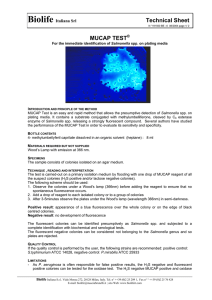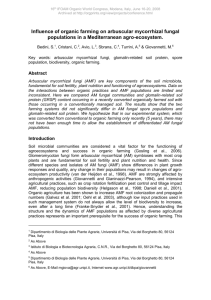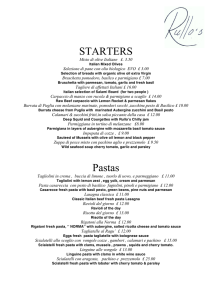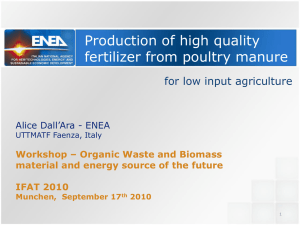Investigation on intestinal bacterial flora and
advertisement
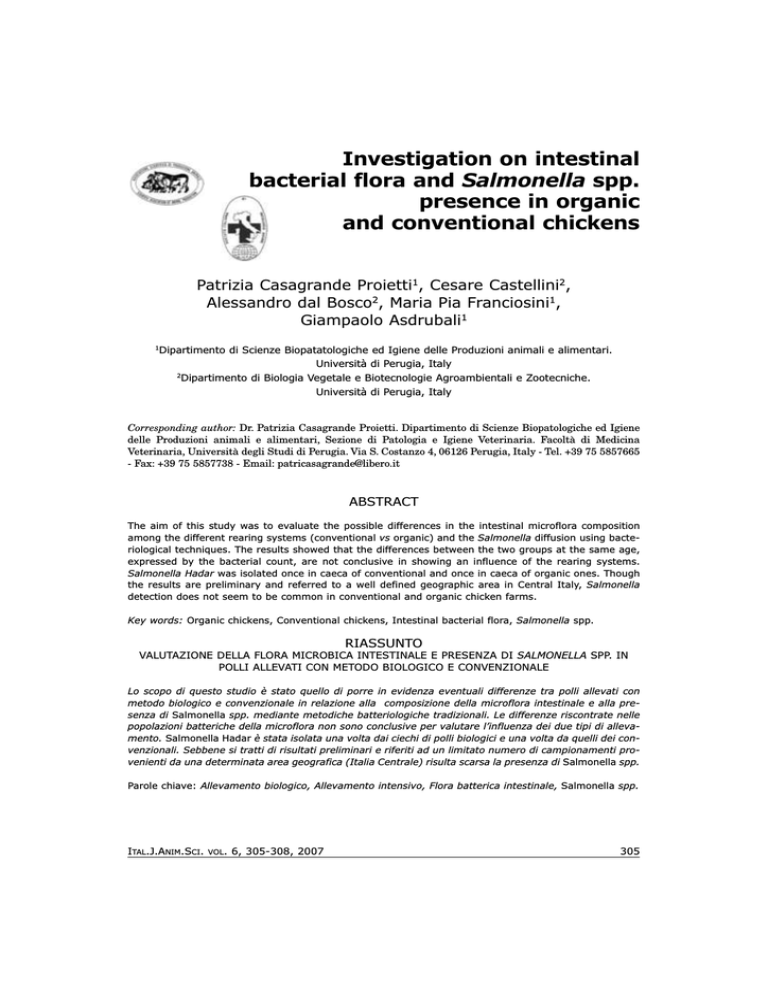
Investigation on intestinal bacterial flora and Salmonella spp. presence in organic and conventional chickens Patrizia Casagrande Proietti1, Cesare Castellini2, Alessandro dal Bosco2, Maria Pia Franciosini1, Giampaolo Asdrubali1 1 Dipartimento di Scienze Biopatatologiche ed Igiene delle Produzioni animali e alimentari. Università di Perugia, Italy 2 Dipartimento di Biologia Vegetale e Biotecnologie Agroambientali e Zootecniche. Università di Perugia, Italy Corresponding author: Dr. Patrizia Casagrande Proietti. Dipartimento di Scienze Biopatologiche ed Igiene delle Produzioni animali e alimentari, Sezione di Patologia e Igiene Veterinaria. Facoltà di Medicina Veterinaria, Università degli Studi di Perugia. Via S. Costanzo 4, 06126 Perugia, Italy - Tel. +39 75 5857665 - Fax: +39 75 5857738 - Email: patricasagrande@libero.it ABSTRACT The aim of this study was to evaluate the possible differences in the intestinal microflora composition among the different rearing systems (conventional vs organic) and the Salmonella diffusion using bacteriological techniques. The results showed that the differences between the two groups at the same age, expressed by the bacterial count, are not conclusive in showing an influence of the rearing systems. Salmonella Hadar was isolated once in caeca of conventional and once in caeca of organic ones. Though the results are preliminary and referred to a well defined geographic area in Central Italy, Salmonella detection does not seem to be common in conventional and organic chicken farms. Key words: Organic chickens, Conventional chickens, Intestinal bacterial flora, Salmonella spp. RIASSUNTO VALUTAZIONE DELLA FLORA MICROBICA INTESTINALE E PRESENZA DI SALMONELLA SPP. IN POLLI ALLEVATI CON METODO BIOLOGICO E CONVENZIONALE Lo scopo di questo studio è stato quello di porre in evidenza eventuali differenze tra polli allevati con metodo biologico e convenzionale in relazione alla composizione della microflora intestinale e alla presenza di Salmonella spp. mediante metodiche batteriologiche tradizionali. Le differenze riscontrate nelle popolazioni batteriche della microflora non sono conclusive per valutare l’influenza dei due tipi di allevamento. Salmonella Hadar è stata isolata una volta dai ciechi di polli biologici e una volta da quelli dei convenzionali. Sebbene si tratti di risultati preliminari e riferiti ad un limitato numero di campionamenti provenienti da una determinata area geografica (Italia Centrale) risulta scarsa la presenza di Salmonella spp. Parole chiave: Allevamento biologico, Allevamento intensivo, Flora batterica intestinale, Salmonella spp. ITAL.J.ANIM.SCI. VOL. 6, 305-308, 2007 305 CASAGRANDE PROIETTI et al. Introduction Modification in poultry production systems by affecting animal density, feeding system, animal welfare as well as pharmacological treatments are expected to modify the intestinal bacterial colonization and the diffusion of Salmonella (Bailey and Cosby, 2005). Large studies on the intestinal bacterial flora of chickens have been performed in animals intensively reared using conventional (Salanitro et al., 1974) and molecular procedures (Jangrang et al., 2003; Bjerrum et al., 2006). The main bacteria in cecum are obligate anaerobes, while Lactobacillus, Enterococcus and Streptococcus are prevalent in ileum. The data reported in literature refer to chickens intensively reared while studies relating to organic chickens are poor (Bailey and Cosby, 2005). The objective of this study was to consider the possible differences in intestinal microflora and the Salmonella presence among the different rearing systems by traditional procedures. Material and methods The investigations concerning the evaluation of the intestinal bacterial counts were performed in 2 conventional (20.000 chickens) and 2 organic (4.000 chickens) farms, located in Central Italy. In the conventional farms, diets and housing system were standard and genetic strain was represented by Ross 308. With respect to organic farms, according to the EU rules (EC Council Regulation No 1804/99), the diets consisted of organic components (65% of cereals of dm) and an intermediate growing strain was used. As prevention for Coccidiosis the vaccine, administered at one day of life, was used in all farms tested. Twenty-four intestinal samples from organic farms were collected from ileum and 24 from caecum during the production cycle (40 days) and immediately before slaughter (80 days). The same number of samples were collected from conventional chickens at 40 days of age (at slaughter).The caecum and the ileum of each 306 bird was accurately removed and 6 samples of the intestine content of single birds were pooled to obtain 4 samples of each intestinal region (ileum and caecum). MacConkey agar, Violet red bile agar and KF streptococcus agar were respectively used for the enumeration of Enterobacteriaceae, Streptococcaceae and Enterococcaceae. Baird Parker agar and Mannitol salt agar were used for enumeration of Staphylococcaceae. All the plates were incubated at 37°C, aerobically, for 24h-48h and the the number of grown colonies was determined. For the enumeration of anaerobic bacteria, Schaedler agar, enriched with 5% sheep blood and 1 mg/mL K1 vitamin, was used as anaerobic blood agar. The anaerobic bood agar supplemented with 7.5mg/mL vancomycin and 100mg/mL kamamycin was used as kanamycin vancomycin blood agar. For the enumeration of anerobic bacteria Reinforced Clostridial agar was also used. Anaerobic incubation was made in anaerobic jars (Oxoid) for 48h. Anaerobic conditions were obtained with Anaerogen (Oxoid) and were controlled by methyl blue strips as oxidation reduction indicator. For the enumeration of lactobacilli Rogosa agar was used. The plates were incubated for 3 days at 35°C under microaerophilic condition. Total aerobic count was determined used Standard plate count agar medium. The plates were incubated at 37°C, aerobically, for 24h-48h. The investigations on Salmonella diffusion were performed in 4 organic (4000 chickens) and 4 conventional (20.000 chickens) farms, located in the Central Italy. During the production cycle environmental samples consisting of 5 pools of litter (250g of each pool), 2 pools of dust (50g of each pool) and 1 water (1lt) samples were once collected. At slaughterhouse 60 caecal samples per farm, subdivided in 2 pools, were also collected. The procedure used for Salmonella isolation was the ISO 6579 2002 method. Statistical analysis - Data were expressed as n.x106 and analysed by linear models (STATA, 2005) comprising the effect of farming systems. The effect of age (40 vs 80) was valued only for organic birds. Significance of differences was assessed by the t-test. ITAL.J.ANIM.SCI. VOL. 6, 305-308, 2007 SALMONELLA Results and discussion Data relating to intestinal bacterial flora count of both conventional and organic chickens at 40 days are shown in Table 1. In particular, the values of some facultative anaerobic bacteria, such as lactobacilli and enterococci, usually more common in ileum, were higher in the caecum of both organic and conventional chickens. The anaerobic bacteria values confirmed the previous findings (Salanitro et al., 1974); indeed they are higher in the final intestinal tract of both groups. Their numerical value was also significantly higher in Table 1. SPP. PRESENCE IN CHICKENS conventional caecal samples. The comparison between the samples collected at 40 and 80 days in organic chickens are reported in Figures 1a-1b. In the ileum, the total anaerobia bacteria and the enterobacteria greatly increased with the age whereas lactobacilli, enterococci and the total aerobic bacteria decreased (Figure 1). In the caecum the bacteria were 10 fold more concentrated than in ileum (Figure 2) as reported in literature (Apajalahti et al., 2004). With respect to Staphylococci count, higher in conventional than organic rearing system, their characterisation is necessary to speculate on their origin. Bacterial counts from the intestinal tract of organic and conventional chickens at 40 days (n.x106). Total aerobic bacteria Total anaerobic bacteria Enterobacteria Staphylococci Enterococci Lactobacilli Conventional Ileum Caecum Ileum 46.7a 242.5b 18.3a 7.6b 16.4a 3.9a 57.5a 0.1a 7.0a 0.1a 35.8a 19.4a 296.4b 631.7c 70.8b 19.1c 101.4b 104.5b Organic Caecum SEM* 307.2b 293.1b 59.5b 6.7b 120.8b 120.0b 44.8 132.5 9.6 3.3 33.8 22.5 a.b. c: P<0.05. *SEM: standard error mean. Figure 1. Bacterial distribution in ileum of organic chickens at different ages (95% confidence interval). 200 n x 106 150 40 100 80 50 0 i ia i ria bia occ rob occ cte ero a ae loc ba roc n . y o e t a r t h . to p te en tot en sta ITAL.J.ANIM.SCI. VOL. 6, 305-308, 2007 lli aci ob t c la 307 CASAGRANDE PROIETTI et al. Figure 2. Bacterial distribution in caecum of organic chickens at different ages (95% confidence interval). 1400 1200 n x 106 1000 800 40 600 80 400 200 0 i i a ia ia lli eri occ occ aci rob rob loc act ob roc ae ae y t b e n . c h t o t p la .a to en ter sta tot en Salmonella Hadar was isolated twice in the caecum samplings: once from conventional chickens and once from organic ones Conclusions The present study showed that the caecum of both conventional and organic chickens showed a major number of bacteria than the ileum; however, the differences between the two groups, detected in bacterial count at the same age, are not sufficient to evidence an influence of the rearing systems. The value detected for the total anaerobia suggests that farming system can affect the equilibrium among the different bacterial population. Though the investigations refer to a limited number of samples the Salmonella spp. detection does not seem to be common in conventional and organic chicken farms. Bailey and Cosby (2005) did not agree in assuming that the free range or organic conditions can influence the Salmonella presence in the chickens. However, it has to be highlighted that in the last years the incidence of Salmonella infection has declined all over the world (Carraminana et al., 1997). The isolation of Salmonella Hadar confirmed the recent worldwide diffusion of this serotype, likely due to its resistance to fluoroquinolones (Tran et al., 2004). 308 REFERENCES Apajalahty, J.H., Kettunen, A., Holben, W.E., Graham, G., 2004. Characteristic of the gastrointestinal microbial community, with special reference to the chicken. World Poultry Sci. J. 60:223-232. Bailey, J.S., Cosby, D.E., 2005. Salmonella prevalence in free-range and certified organic chickens. J. Food Prot. 68:2451-2453. Bjerrum, L., Engberg, R.M., Leser, T.D., Jensen, B.B., Finster, K., Pedersen, K., 2006. Microbial community composition of the ileum and cecum of broiler chickens as revealed by molecular and culturebased techniques. Poult. Sci. 85:1151-1164. Carraminana, J.J., Yanguela, J., Blanco, D., Rota, C.,Augustin, A., Arino, A., Herrera, A., 1997. Salmonella incidence and distribution of serotypes throughout processing in a Spanish poultry slaughterhouse. J. Food Prot. 60:1312-1317. Jangrang, L., Umelaalim, I., Harmon, B., Hofacre, C., Maurer, J.J., Lee., M.D., 2003. Diversity and succession of intestinal bacterial community of the maturing broiler chickens. Appl. Environ. Microbiol. 69:6816-6824. Salanitro, J.P., Blake, I.G., Muirhead, A.P., 1974. Studies on the cecal microflora of commercial broiler chickens. Appl. Microbiol. 28:439-447. Tran, T.P., Ly, T.L.K., Nguyen, T.T., Akiba, M., Ogasawara, N., Shinoda, D., Okatani, A.T., Hayashidani, H., 2004. Prevalence of Salmonella spp. in pigs, chickens and ducks in the Mekong Delta, Vietnam. J. Vet. Med. Sci. 66:1011-1014. ITAL.J.ANIM.SCI. VOL. 6, 305-308, 2007
